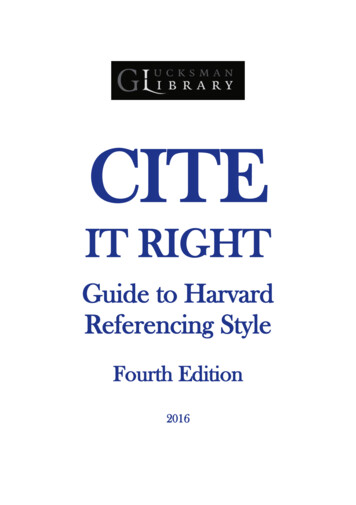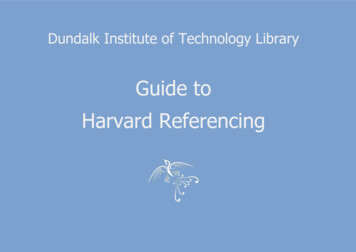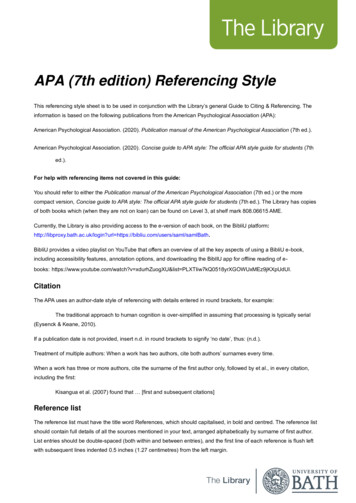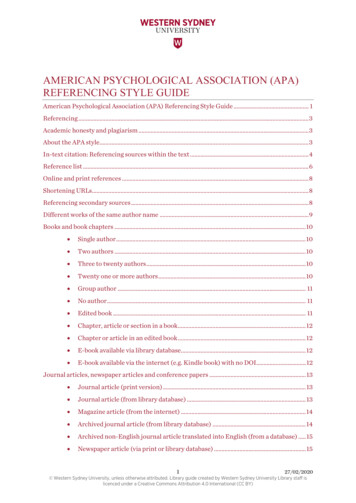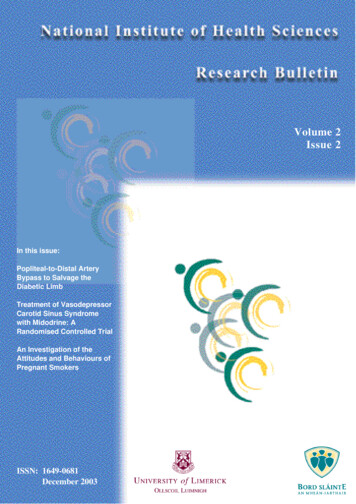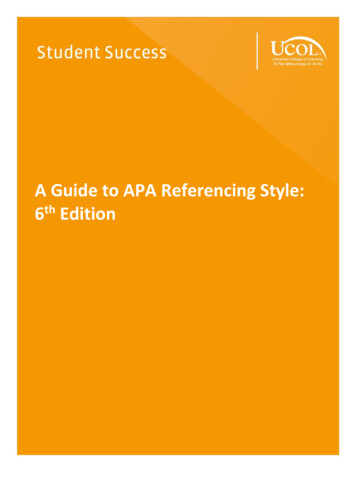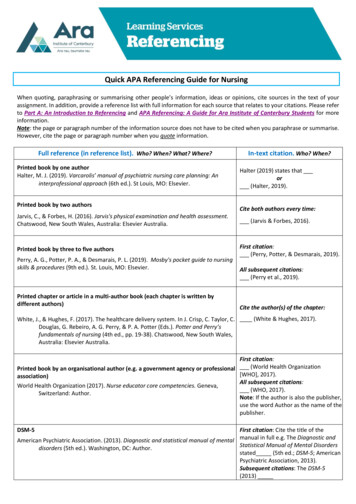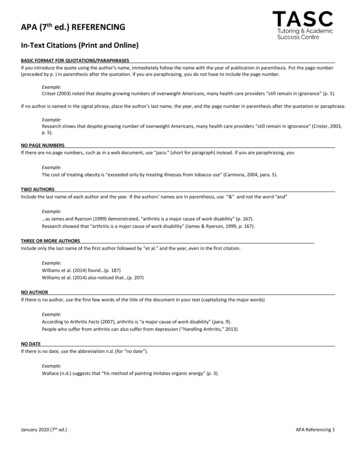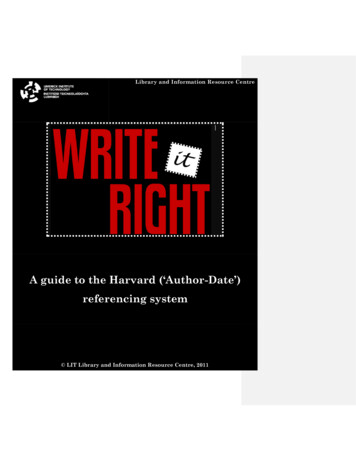
Transcription
Library and Information Resource CentreA guide to the Harvard (‘Author-Date’)referencing system LIT Library and Information Resource Centre, 2011
LIT Library and Information Resource Centre - A guide to the Harvard (‘Author-Date’) Referencing System.ContentsWhat is referencing? . .2Which referencing system should you use? . 2Harvard (‘Author-date’) system . 2What are the essential elements? . 3Why should you reference? . 3What is plagiarism? . 3Examples of plagiarism . 4Permission to quote, adapt or reprint . 4How does referencing work? . 4What is citing? . 5Using direct quotations . 5How to cite in the body of your text . 7Secondary referencing . 8Citing page numbers in text: some rules . 9Using tables, figures, images and graphs in the body of your text . 10The Reference List. 11Differences between a Reference List and a Bibliography . 11Compiling your Reference List or Bibliography . 11Example of a Reference List . 12Date and place of publication . 13Publisher . 14Titles . 14Acronyms and initials . 14Capitalisation . 15Paraphrasing . 16Examples of paraphrasing . 16Paraphrase or use quotations? . 17Quick- find referencing guide . 18Endnote and Endnote Web . 37Bibliography . 37Credits . 37Page 1 of 37
LIT Library and Information Resource Centre - A guide to the Harvard (‘Author-Date’) Referencing System.Please Note: There are different versions of Harvard referencing and this booklet is only a guide; if youhave any doubts about your referencing you should always check with your lecturer.What is Referencing?When you write an assignment at the Institute you are required to indicate that you have used the ideas andwritten material belonging to other authors in your own work both in the text of your assignment and in areference list at the end of your assignment. This practice of acknowledging authors is known as referencing. Thefollowing are examples of sources that you might acknowledge in your assignment: Books; Journal articles; Electronic journal articles; World Wide Web pages, paintings, images, drawings and diagrams; Emails; Social Media; Video, DVD, Film & audio tape recordings; Newspapers; Conference papers; Radio/TV broadcasts (please check with your lecturer if it is advisable to use these in your assignment) Personal communication; Interviews (If this is a personal interview, you must always ask permission of the interviewee before using suchmaterial); and, Theses and other academic work.Which referencing system should you use?There are many different referencing systems widely used in academic writing. LIT acknowledges 2 systems: Author- Date systems commonly known as Harvard or APA (American Psychological Association)Numerical systems sometimes referred to as Footnoting, Endnoting or Vancouver.Harvard (‘Author-date’) systemThere are two parts to the author-date system of referencing. The author and the date are referred to in the text or main body of your writing (this is called ‘citing’ or ‘intext referencing’)All of the resources referred to in the body of the writing are included in the reference list at the end of theassignment.Page 2 of 37
LIT Library and Information Resource Centre - A guide to the Harvard (‘Author-Date’) Referencing System.What are the essential ume& IssuePlace DateaccessedBookBookchapterJournalarticle(Print orPDF)Journalarticle(Web)WebsiteWhy should you reference? You receive credit for all the background research and hard work you've done which will contribute towards agood mark (Epigeum 2011).You receive feedback on work that is your own so that you can understand how to improve and develop yourability to write and express yourself clearly.It places your own work in context by showing how it relates to prior research and current academic debatesin your discipline.It demonstrates your intellectual integrity by acknowledging the influence of other people's work on your ownand by distinguishing clearly between their work and your own ideas.It allows your reader to explore the subject further by looking up your sources and reviewing them in greaterdepth.Plagiarism may be unintentional and the result of carelessness but it is still plagiarism. Remember thatacademics are much attuned to detecting plagiarism because they are in command of the relevant subjectliterature and are sensitive to changes in writing style.Disciplinary procedures may apply in cases of serious proven plagiarism.What is Plagiarism?Plagiarism is ‘the deliberate or reckless representation of another’s words, thoughts, or ideas as one’s own withoutattribution in connection with submission of academic work, whether graded or otherwise’ (University of NorthCarolina 2009).Page 3 of 37
LIT Library and Information Resource Centre - A guide to the Harvard (‘Author-Date’) Referencing System.Examples of Plagiarism Copying chunks of text without using quotation marks and without appropriate acknowledgement; forexample, cutting-and-pasting text from website encyclopaedias or online research papers or copying paperswritten by students who took the same course in previous years.Copying text and making very minor changes and without appropriate acknowledgement. This is an exampleof unacceptable paraphrasing.Copying a picture or photo from the Internet without appropriate acknowledgement. If you use imagesprotected by copyright you must also obtain permission from the copyright owner.Copying all or part of the engineering drawings of another.Copying the melody of a song in a song-writing assignment without acknowledgement or permission from thecopyright owner (if appropriate).Using another person's numerical spreadsheet without appropriate acknowledgement.Duplicating your own work, for example, by submitting almost exactly the same work for two differentassignments.(In computer programming) Using code developed by another person without acknowledging him or her asthe person who developed it (Epigeum 2011).Permission to quote, reprint or adaptYou may need written permission from the owner of copyrighted work if you include lengthy quotations or if youinclude reprinted or adapted tables of figures or drawings.The term reprinting indicates that the material is reproduced exactly as it appeared originally withoutmodifications in the way in which it was intended (e.g. use of direct quotes).The term adaptation refers to the modification of material so that it is suitable for a new purpose (e.g.paraphrasing). It is the author’s responsibility to find out whether permission is required from the copyright ownerand to obtain it for all works.How does referencing work?Referencing has 2 essential elements: Citing- acknowledging sources within the text.Reference list- detailed list of references which have been cited within the text.Page 4 of 37
LIT Library and Information Resource Centre - A guide to the Harvard (‘Author-Date’) Referencing System.What is citing?If you have used an idea from a book, journal article, etc. you must acknowledge this in your text. This is referredto as citing.Author prominent citingThis citation method gives prominence to the author’s surname (family name) as part of your sentence with thedate and page number (the page number is necessary if you are quoting directly) in parentheses (round brackets).ExampleGregg (1994 p. 7) describes the primary function of the comma as the setting off of ‘nonessentialexpressions that interrupt the flow of thought from subject to verb to object or complement’.Information prominent citingThis citation method gives prominence to the information with the required referencing details in parentheses atthe end of the citation.ExampleLimited fossil resources and severe environmental problems ‘require new sustainable electricitygeneration options’ (Zhao 2008 p. 3).Using direct quotationsQuotations should be used sparingly, selected carefully, used in context, and integrated into your text andreproduced exactly (including the words, spelling, punctuation, capitalisation and paraphrasing of the originalwriter). LIT policy permits authors to use a maximum of three figures or tables from a journal article or bookchapter, single text extracts of fewer than 400 words, or a series of text extracts that total fewer than 800 wordswithout requesting formal written permission from the author.A quotation is used if: Misinterpretation would result from a change to the words. A major argument needs to be recorded as evidence. It is important to comment on, refute or analyse the ideas expressed. It is a particularly elegant or forceful phrase.Short quotationsShort quotations (fewer than 30 words) should: Be incorporated into your sentence without disrupting the flow of your paragraph. Have single quotation marks. Have the full stop after the citation. Keep the same font size.Page 5 of 37
LIT Library and Information Resource Centre - A guide to the Harvard (‘Author-Date’) Referencing System.Long quotationsLong quotations (more than 30 words) should: Be introduced in your own words. Begin on a new line. Be fully indented by default (i.e. 1.27 cm) from the left margin. Be in single line spacing.Separate the quotation from the lead-in statement with one blank line. The lead-in statement ends with a colon (:).Separate the quotation from the text that follows it with one blank line. This is illustrated below.ExampleGregg (2001 p. 4) emphasizes the place of the semicolon in academic writing:The semicolon has always been a neurotic creature, continually undergoing an identity crisis. After all it isa half comma and half period, and from its name you would think it is a half colon. It is hardly any wonder,then, that a lot of people are half crazy trying to determine who the semi-colon really is and what itsmission in life is supposed to be.Quotation marksQuotation marks are not used for longer quotations. When using an information prominent long quotation, the fullstop will be included after the last sentence of the quotation after the citation as shown below.ExampleGregg cautions against the careless use of punctuation:One important caution about punctuation. If you find it particularly hard to determine the appropriatepunctuation for a sentence you have written, the chances are that the sentence is improperlyconstructed. To be on the safe side, recast your thought in a form you can handle with confidence. In anyevent, do not try to save a badly constructed sentence by means of punctuation (Gregg 2001, p. 4).Words omitted from quotationsTo omit words from quotations, use an ellipsis ( ). The quotation must still keep the same sense.For example:Gregg (1994 p. 7) describes the primary function of the comma as the setting off of ‘nonessentialexpressions that interrupt the follow of thought from subject to verb to object or complement and itseparates elements within a sentence to clarify their relationship to one another’.If the quotation does not begin at the start of a sentence, an ellipsis should be used to convey this to the reader.For example:Page 6 of 37Commented [N1]: Remove comma after 2001
LIT Library and Information Resource Centre - A guide to the Harvard (‘Author-Date’) Referencing System.:. many writers have difficulties with the use of capitalization in essays (Gregg 2001, p. 10).Commented [N2]: Remove comma after 2001Double quotationsFor a double quotation—that is, a quotation within a quotation—use double quotation marks inside singlequotation marks:‘”When your mama was the geek, my dreamlets” are the first words in Katherine Dunn’s Geek Love and this bookexplores how a family of freaks who are the grotesque attractions in their own carnival accept themselves and usetheir status as freaks to leverage themselves to a position of power’.How to cite – in the body of your textWhen you cite someone else’s work, you must always state the author/editor and the date of publication. If thework has two authors/editors you must cite both names when citing in the body of your own work. Only use theauthor and date; do not include the title, place of publication, etc., because these full details of the item arewritten in your reference list at the end of your essay.Example – 1 Author cited in the body of your text:O’Brien (2001) emphasizes the importance of wind energy for the national economy.Example – 2 Authors cited in the body of your text:The work of O’Brien & Ryan (2001) stresses the importance of renewable energy for the rejuvenation ofeconomies.For a work which has three or more authors/editors the abbreviation ‘et al.’ should be used after the first author’sname.Example:The work of O’Brien et al. (2001) emphasises the progress Ireland has made in the field of renewableenergy in recent years and suggests future developments.For a work which has the same author and was written in the same year as an earlier citation, you must use alower case letter after the date to differentiate between the two.Example:The work of O’Brien (2001b) emphasizes the need for appropriate financing to be made available forrenewable energy projects.Page 7 of 37
LIT Library and Information Resource Centre - A guide to the Harvard (‘Author-Date’) Referencing System.Citing from books with chapters written by different authorsSome books may contain chapters written by several different authors. In this case the author who wrote thechapter should be cited not the editor of the book.Example:Smith (2004) demonstrates the value of In the Reference List:Smith, A. (2004) Innovative solutions to saving energy, in Healey, M. & Scott, P. (eds.) Alternative energydemystified, London: McGraw-Hill, 65-89.Secondary referencingIf you are reading a source by one author- in our example O’Brien (2009) and they cite or quote work by anotherauthor (in our example Murphy 2004) you may in turn cite or quote the original work (e.g. that of Murphy 1994) asa secondary reference.It is always best practice to try and locate the original reference and secondary references should only be used if itis difficult to access the original work. You must remember that in a secondary reference you are seeing theoriginal author's work from someone else's perspective.In Text example:A study by Murphy (2004, cited in O’Brien 2009) discusses the role of wind power in alleviating Ireland’sdependence on imported fossil fuels.ORO’Brien (2009) cites the role of Murphy (2004) which looks at the role of wind power in alleviatingIreland’s dependence on fossil fuels.Reference list example:O’Brien, J. (2009). The development of wind power energy in Ireland: a qualitative and quantitative study,London: Macmillan.Page 8 of 37
LIT Library and Information Resource Centre - A guide to the Harvard (‘Author-Date’) Referencing System.Citing page numbers in text: some rulesAuthor(s) name: Use surname only.Use both authors’ surnames linked by ‘&’ for 2 authors. Note- the ampersand (&) should only be used inciting- not in the Reference List.Use first author’s surname and et al for 3 or more authors.Year: Give full four digits for year.Pages: Abbreviate to p. for single page and pp. for page range.Give full numbers for page range e.g. pp. 412-427.Give page numbers if you are quoting directly e.g. (O’Brien 2004 p. 56).If you are paraphrasing it is not essential to give page numbers e.g. (O’Brien 2004).Citing page numbers Example: quote from a single page: (O’Brien 2009 p. 16).Example of quote from multiple pages: (O’Brien 2003 pp. 31-32).Structure your sentence to include the in-text citation: According to O’ Brien (2005 p. 6).Use single quotation marks (double quotation marks are usually used for quoting direct speech) and state the pagenumber.Example – Short quotation:O’Brien (2004 p. 18) acknowledges Ireland’s ‘overreliance on fossil fuels’.For quotes over two lines have a separate indented paragraph.Example – Long quotationO’Neill (2008 p. 43) states:Fossil fuels take millions of years to form and reserves are being depleted much faster than new ones arebeing formed and so are non-renewable resources. As fossil fuels are used up, new reserves of fossil fuelswill become harder and more expensive to source until it will become uneconomical to source energyfrom fossil fuels.If you wish to use a long quotation which is over 2 lines in length but wish to omit some of the text you can removethe unwanted text and replace with ‘ .’ This is known as an ellipsis.Example – Long quotationO’Neill (2008 p. 43) states:Fossil fuels take millions of years to form and reserves are being depleted much faster than new ones arebeing formed and so are non-renewable resources new reserves of fossil fuels will become harder andmore expensive to source until it will become uneconomical to source energy from fossil fuels.Page 9 of 37
LIT Library and Information Resource Centre - A guide to the Harvard (‘Author-Date’) Referencing System.When you use quotations within your text, sometimes you may want to insert one or two words in the quotationso that your complete sentence is grammatically correct. To indicate that you have inserted words into aquotation, these have to be enclosed in square brackets.O’Neill (2008 p. 43) states:Fossil fuels take millions of years to form and reserves are being depleted much faster than new ones arebeing formed and so are non-renewable resources [and] new reserves of fossil fuels will become harderand more expensive to source until it will become uneconomical to source energy from fossil fuels.Charts, diagrams, pictures etc. should be treated as direct quotes in that the author(s) should be acknowledgedand page numbers shown; both in your text where the diagram is discussed or introduced, and in the caption youwrite for it.Using tables, figures, images and graphs in the body of your textFigure 5. From O’Neill, J. and O’Brien, P. (2011) Management of European Union Projects: a guidebook for projectmanagers, Limerick: Limerick Institute of Technology, p. 38. Copyright 2011 by John O’ Neill and Patrick O’ Brien.Reprinted with permission.*Please note that if the table/figure/image/graph has been adapted – Adapted with permission is stated instead ofReprinted with permission.*Please check with your lecturer/supervisor if you are expected to use published illustrations in your assignments.The above figure would also feature in a List of Figures in your essay, dissertation or thesis.Page 10 of 37
LIT Library and Information Resource Centre - A guide to the Harvard (‘Author-Date’) Referencing System.The reference listThe reference list is a list of all the sources that have been cited in your work showing books, journals, etc. listed inone list not in separate lists according to resource type i.e. you don’t put books in one list and journals in anothereverything is together in one list as follows: In alphabetical order by author/editor. Books, journal articles, e-journal articles, etc. are laid out in a defined template that must be adhered to.A reference list contains all the items you have cited or directly quoted from.Differences between a reference list and a bibliography:The reference list only identifies sources referred to (cited) in the text of your assignment. A bibliography ispresented in the same format as a reference list but it includes all material consulted in the preparation of yourassignment. In other words, a bibliography presents the same items as a reference list but it also includes all othersources which you have read or consulted but did not cite. A bibliography allows you to show to your reader(examiner) the unused research you carried out. The bibliography will show your extra effort.Compiling your reference list or bibliography All in-text references must be included in an alphabetical list, by author’s surname, at the end of the work. Asstated earlier, this is known as the Reference List. A bibliography is a list of all works you used in preparationof the work, but which were not necessarily cited/referred to. This list must not be numbered. When there is no author, use the title. References in your reference list must be a full description of the in–text references (citations). If there is more than one publication by the same author, arrange the works in chronological order. In your reference list/bibliography the following abbreviations are accepted:& (ampersand) appears between the names of authors but only where these appear in brackets in in-text(citation) referencing and not in the reference list.(ed.) editoreditor-(eds.) editorscol. columneditorscolumn-comp(s). compiler/compilersed. editioncompiler/compilersedition-et al.n.d. or s.d.and othersno knowledge of the date-no.par.numberParagraph-s.l.s.n.no place of publicationpublisher unknown-vol.volumePage 11 of 37
LIT Library and Information Resource Centre - A guide to the Harvard (‘Author-Date’) Referencing System.Example of a reference listAndrews, J. (2007) Energy science: principles, technologies and impacts, Oxford: Oxford University Press.Bradford, T. (2006) Solar revolution: the economic transformation of the global energy industry, Ebrary, [online],available: http://mislibsrv.lit.ie/search S0?/tsolar revoluition/tsolar revoluition/3%2C0%2C0%2CB/frameset&FF tsolar revolution the economic transformation of the global energy industry&1%2C1%2C/indexsort - [accessed 24 Feb 2011].Burton, T. (2004) Wind energy handbook, New York N.Y.: Wiley.Byrne, C. (2007). Renewable energy: meeting Ireland’s future energy demands, unpublished dissertation (B.Sc),Limerick Institute of Technology.Campbell, I.M. (1986) Energy and the atmosphere: a physical-chemical approach, Chichester: Wiley.Doty, S. and Turner, W.C. (2009) Energy management handbook, Lilburn, GA: Fairmont Press.Elliott, D. (2002) Energy, society and environment: technology for a sustainable future, Ebrary, [online], available:http://mislibsrv.lit.ie/search S0?/tenergy/tenergy/51,81,86,B/l856 b1096004&FF tenergy society and environment technology for a sustainable future&1,1,,1,0 [accessed 24 Feb 2011).Jackson, J. (2008) Energy budgets at Risk (EBaR) : a risk management approach to energy purchase and efficiencychoices, Ebrary, [online], available:http://mislibsrv.lit.ie/search S0?/tenergy budgets/tenergy budgets/1,1,1,B/l856 b1114331&FF tenergy budgets&1,1,,1,0/startreferer//search S0/tenergy budgets/tenergy budgets/1,1,1,B/frameset&FF tenergy budgets&1,1,/endreferer/ [accessed 01 Feb 2011).Moss, K. (2006) Energy management in buildings, London: Taylor and Francis.Nersesian, R.L. (2007) Energy for the 21st century: a comprehensive guide to conventional and alternative sources,Ebrary, [online] available:http://mislibsrv.lit.ie/search S0/?searchtype a&searcharg nersesian&SORT D&extended 0&SUBMIT Search&searchlimits &searchorigarg tnersesian [accessed 02 February 2011].Sahin, A.D (2004) Progress and recent trends in wind energy, Progress in Energy and Combustion Science, 30 (5):501-543, available: http://www.sciencedirect.com/science? ob ArticleURL& udi B6V3M-3Y8YWF613& user 885412& coverDate 04%2F01%2F1998& alid 1654738037& rdoc 1& fmt high& orig search& origin search& zone rslt list item& cdi 5734& sort r& st 4& docanchor & ct 2& acct C000047354& version 1& urlVersion 0& userid 885412&md5 50dea27f88793843afb297417215023a&searchtype a [accessed 10 Feb2011].Sesto, E. and Casale, C. (1998) Exploitation of wind as an energy source to meet the world’s electricity demand,Journal of Wind Engineering and Industrial Aerodynamics, 74 (2): 45-50, available: Science Direct [accessed 02 Feb2011].Sexton, I. (2010) Wind energy: the impact on the rural community, unpublished dissertation (B.Sc), LimerickInstitute of Technology.Wengenmayr, R and Buhrke, T. (2008) Renewable energy: sustainable energy concepts for the future, Weinheim:Wiley.Page 12 of 37Commented [N3]: Remove full stop after (2007)
LIT Library and Information Resource Centre - A guide to the Harvard (‘Author-Date’) Referencing System.Date of publication The date of publication of the work usually appears on the verso (back) of the title page of the work (theimprint page). If no date is given for a publication, use an approximate date following the examples below:Publication date unknown or uncertainExample of convention to useone or the other date is correct(1993 or 1994)the probable date1994?the approximate datec. 1994when the decade is known but not the year199-When there is no knowledge of the date at all (sine anno/no date)s.a. or n.d.Place of Publication The place of publication is given in the language in which you are writing, for example, English or Gaeilge. If there is more than one place of publication given give only the first place. If no place can be traced, the abbreviation s.l. (sine loco) is used. The place of publication is the town/city. However, for the United States of America, the State should also beincluded. See the table below for the abbreviations to be daNev.ArkansasArk.New HampshireN.H.CaliforniaCalif.New JerseyN.J.ColoradoColo.New MexicoN.Mex.ConnecticutConn.New YorkN.Y.DelawareDel.North CarolinaN.C.District ofColumbiaFloridaD.C.North Hi.OregonOreg.IdahoId.PennsylvaniaPa.Page 13 of 37
LIT Library and Information Resource Centre - A guide to the Harvard (‘Author-Date’) Referencing System.IllinoisIll.Rhode IslandR.I.IndianaInd.South CarolinaS.C.IowaIa.South higanMich.West iMiss.WyomingWyo.MissouriMo.Publisher A colon (:) separates the place of publication and the publisher, e.g. Oxford : Oxford University Press.If no publisher is given, the abbreviation s.n. (sine nomino) may be used.Initials of publishers are usually omitted. E.g J. Wiley is referenced as Wiley. Initials are only used if it is necessary to distinguish between different publishers, e.g. W.H. Allen and J.A.Allen.Titles Note that the titles of published works are always italicized.This means that the titles of unpublished works are never italicized.For journals, the title of the journal is always italicized.The title of a journal article is never italicized.The title of a journal must not be abbreviated. For example, the British Medical Journal is not abbreviated toBMJ. Only the first word and proper nouns of a journal article title begin with an upper case letter. All relevant words of the journal title begin with an
When you write an assignment at the Institute you are required to indicate that you have used the ideas and written material belonging to other authors in your own work both in the text of your assignment and in a reference list at the end of your assignment. This practice of acknowledging authors is known as referencing.
